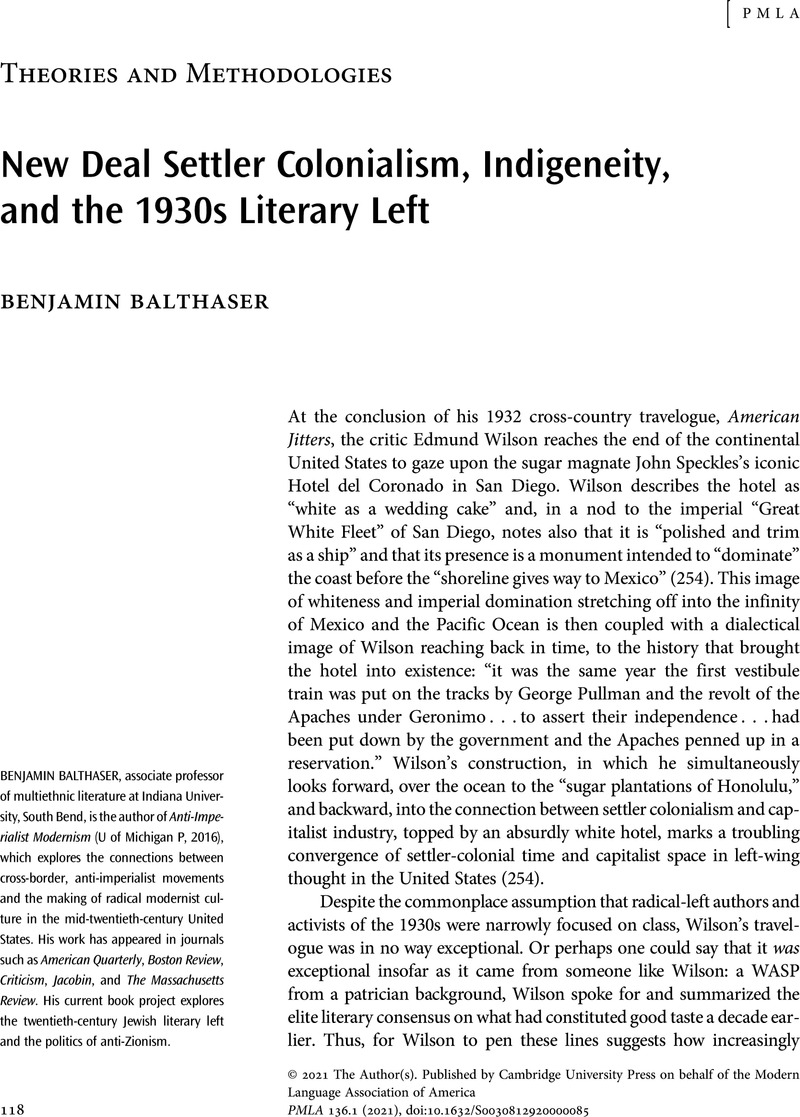No CrossRef data available.
Article contents
New Deal Settler Colonialism, Indigeneity, and the 1930s Literary Left
Published online by Cambridge University Press: 27 January 2021
Abstract
An abstract is not available for this content so a preview has been provided. Please use the Get access link above for information on how to access this content.

- Type
- Theories and Methodologies
- Information
- Copyright
- Copyright © 2021 The Author(s). Published by Cambridge University Press on behalf of the Modern Language Association of America
References
Works Cited
Adi, Hakim. “The Negro Question: The Communist International and Black Liberation in the Interwar Years.” From Toussaint to Tupac: The Black International since the Age of Revolution, edited by West, M. et al. , U of North Carolina P, 2009, pp. 155–78.Google Scholar
Balthaser, Benjamin. Anti-Imperialist Modernism: Race and Transnational Culture from the Great Depression to the Cold War. U of Michigan P, 2016.Google Scholar
Bruyneel, Kevin. The Third Space of Sovereignty: The Post-colonial Politics of U.S.-Indigenous Relations. U of Minnesota P, 2007.Google Scholar
Deloria, Vine Jr., and Lytle, Clifford. The Nations Within: The Past and Future of American Indian Sovereignty. Random House, 1984.Google Scholar
Dunbar-Ortiz, Roxanne. Roots of Resistance: A History of Land Tenure in New Mexico. U of Oklahoma P, 2007.Google Scholar
Estes, Nick. “Four Principles of the Red Deal.” The Red Nation, 25 June 2019, therednation.org/four-principles-of-the-red-deal.Google Scholar
Estes, Nick. Our History Is the Future: Standing Rock versus the Dakota Access Pipeline and the Long Tradition of Indigenous Resistance. Verso, 2019.Google Scholar
Funes, Yessenia. “The Green New Deal Includes a Powerful Pledge to Indigenous People.” Portside, 21 Feb. 2019, portside.org/2019-02-21/green-new-deal-includes-powerful-pledge-indigenous-people.Google Scholar
Gilroy, Paul. The Black Atlantic: Modernity and Double Consciousness. Harvard UP, 1993.Google Scholar
“The Green New Deal Is Pushing to Secure Greater Rights for Indigenous People.” The Optimist Daily, 19 Feb. 2019, www.optimistdaily.com/2019/02/the-green-new-deal-is-pushing-to-secure-greater-rights-for-indigenous-people.Google Scholar
Le Sueur, Meridel. “Corn Village.” Salute to Spring, International Publishers, 1940, pp. 7–25.Google Scholar
Maher, Neil M. Nature's New Deal: The Civilian Conservation Corps and the Roots of the American Environmental Movement. Oxford UP, 2008.CrossRefGoogle Scholar
McWilliams, Carey. Southern California Country: An Island on the Land. Buell, Sloan and Pearce, 1946.Google Scholar
Pellow, David Naguib. Resisting Global Toxics: Transnational Movements for Environmental Justice. MIT Press, 2007.Google Scholar
Phinney, Archie M. “Numipu among the White Settlers.” Wicazo Sa Review, vol. 17, no. 2, Autumn 2002, pp. 21–42.Google Scholar
Pillen, Corey. “See America: WPA Posters and the Mapping of a New Deal Democracy.” The Journal of American Culture, vol. 31, no. 1, 2008, pp. 49–65.CrossRefGoogle Scholar
Rorty, James. Where Life Is Better: An Unsentimental American Journey. Reynal and Hitchcock, 1936.Google Scholar
Slotkin, Richard. Regeneration through Violence: The Mythology of the American Frontier, 1600–1860. U of Oklahoma P, 1973.Google Scholar
Solnit, Rebecca. “Standing Rock Inspired Ocasio-Cortez to Run: That's the Power of Protest.” The Guardian, 14 Jan. 2019, www.theguardian.com/commentisfree/2019/jan/14/standing-rock-ocasio-cortez-protest-climate-activism.Google Scholar
Wilson, Edmund. American Jitters: A Year of the Slump. Books for Libraries Press, 1968.Google Scholar


